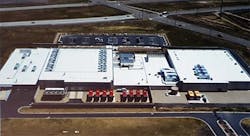Oracle Chairman Larry Ellison isn’t afraid to stir up controversy. With robust cloud growth turbo-charging Oracle’s earnings this week, Ellison was in the mood to skewer his cloud rivals.
“Right now we have a huge technology lead over both Amazon and Azure with our new Generation 2 infrastructure as a service,” Ellison said in Wednesday’s earnings call. “We can deliver ultra-high performance. Oracle’s infrastructure as service cloud now has the ability to run customers’ largest databases, something that is impossible to do using Amazon Web Services. Amazon can only run relatively small Oracle databases in their cloud.”
If Oracle means to compete at scale with Amazon, Microsoft and Google, it will likely need to back up its tough talk with more data centers. As Oracle builds momentum in cloud computing, it has shifted from building its own data centers to leasing wholesale space from data center developers, enabling it to accelerate its expansion.
But Oracle’s cloud infrastructure remains significantly smaller than its three cloud rivals. That’s why Oracle’s strong momentum is good news for data center developers, including the publicly-held real estate investment trusts (REITs), who have been among the leading beneficiaries of the cloud infrastructure expansions by Microsoft and Amazon.
Retooling for the Cloud
Ellison was once known for his disdain for cloudy jargon. But in recent years Oracle has begun shifting to a cloud delivery model.
Oracle now has offerings in all three sectors of the cloud market: software-as-a-service (SaaS), platform-as-a-service (PaaS) and infrastructure-as-a-service (IaaS). Oracle’s SaaS services include enterprise resource planning (ERP) and human resources applications, while its PaaS offerings are led by its Oracle Database Cloud Service, which allows customers to run databases in Oracle’s server farms rather than their on-premise facilities.
In its latest earnings, Oracle’s cloud revenue surged 62 percent to $1.2 billion. The database giant’s SaaS and PaaS units logged growth of 73 percent for the quarter, while its IaaS revenue rose 17 percent.
But Ellison believes Oracle is poised for big things in the IaaS sector, driven by improvements to its data center infrastructure.
‘Very, Very Fast Growth’ as Databases Move
“Some of our largest customers’ are negotiating huge infrastructure as a service contracts to move all their databases to the Oracle cloud,” Ellison said in the earnings call. “You can expect some of those big deals to be announced in the coming weeks. Fast growth in the infrastructure as a service business is new for us. We’ve done well on SaaS and in PaaS over the past few years, but this is the first time we’ve ever had a technology lead in infrastructure as a service.
“An awful lot of our customers are planning to move their database workloads to our cloud, but they’re going to bring their own license,” he continued. “In other words, they own a bunch of Oracle licenses and they’re just going to move those licenses to our infrastructure as a service. We have hundreds of thousands of database customers and we have millions and millions of applications that run on the Oracle database. Most of those customers will move most of their databases and workloads to the cloud. I think the rate of migration is going to accelerate over the years, but it’s going to be at least a five-year run of very, very rapid growth as our database business begins to move.”
Joining the Cloud Arms Race
As we’ve previously noted, the cloud computing arms race is accelerating, and the battle will be waged with data centers. The leading players are moving quickly to amass capacity for the clouds to come, resulting in huge deals for data center space under development.
As it has shifted its ambitions cloudward, Oracle has updated its data center strategy. Until 2015, Oracle ran its online services out of data centers in Austin, Utah and Scotland. It also houses servers with some third-party data center providers.
The evolution of the Oracle Utah Compute Facility (UCF) in South Jordan, Utah illustrates the ongoing changes in technology and best practices, and Oracle’s emphasis on continuous refinement of data center design to strike a balance between sustainability, cost and operational efficiency.
Michael Thrift, Oracle’s Director of Data Center Facilities, describes the operations of the company’s Utah Compute Facility at the 7×24 Exchange Fall Conference in San Antonio. (Photo: Rich Miller)
But the buildout of the Utah facility occurred over two years. By shifting to a wholesale approach – where customers lease finished suites of technical space – Oracle can fill data halls with servers on a shorter timeline. In recent projects, wholesale providers have demonstrated the ability to deploy new capacity from the ground up in as little as six months.
During 2016 Oracle became one of the largest wholesale customers, signing seven deals totaling about 30 megawatts (MW) of space, according to North American Data Centers, which tracks data center real estate leasing. That included four deals that added 20 MW of capacity in Northern Virginia, and three leases totaling 10 MW in Chicago. The company spread the wealth, doing deals with CyrusOne, QTS, Digital Realty and RagingWire, the report said.
In January 2017, Oracle announced three new cloud regions in Virginia, the United Kingdom and Turkey. Oracle says it has doubled the regional presence of its cloud platform in the last 24 months, with 29 regions available globally and more scheduled to come online in APAC, North America, and the Middle East through mid-2018.
Retooling for the Cloud
Will that capacity be enough to sustain the accelerating growth of Oracle’s cloud operations? The company’s lucrative database business is focused on the enterprise sector, and may be able to yield strong revenue from a smaller footprint than its hyperscale rivals. But even 30 megawatts of new space leaves Oracle trailing the massive infrastructure of Amazon, Microsoft and Google, which all operate hundreds of megawatts of data center space.
Oracle’s capital expenditures for the third quarter were $440 million, with cloud infrastructure representing about two thirds of that amount, according to CEO Safra Catz – or about $290 million. That’s an annualized rate of just over $1.1 billion. By comparison, Google spent $10.9 billion on its data centers last year. That’s an apples-to-oranges comparison, as Google builds its own facilities, while Oracle is now leasing wholesale space. Microsoft both builds and leases space, while Amazon leases powered shell space (primarily from data center REIT Corporate Office Properties Trust), a middle path where it completes the internal data halls.
One thing is true for all these cloud builders: Expanding data center space is a capital-intensive business, and large public companies seek to deploy capital incrementally. That’s one reason that data center developers have been under pressure to deliver data center space on shorter timelines. Given Ellison’s projection of five years of accelerated growth, you can expect that Oracle isn’t finished expanding its data center footprint.
About the Author


